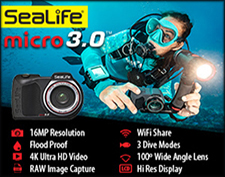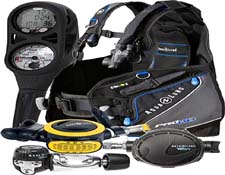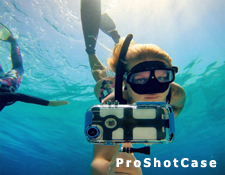

|


|
 |
 |
 |
 |
 |
 |
 |
 |



|
Malaysia Scuba Diving Information
Imagine crystal clear waters surrounding beautiful islands with pure, white beaches. Imagine palm trees swaying in balmy, tropical breezes, all set against a backdrop of lush, green rainforest – this is Malaysia. For scuba divers, Malaysia's biodiversity is nothing short of stunning. The country is divided into two parts – Peninsular Malaysia, which shares a border with the southern end of Thailand, and Malaysian Borneo, which encompasses the northern quarter of the world’s third-largest island. The dive opportunities here are rivaled only by the nation's cultural diversity. Around the hundreds of tropical islands are an incredible choice of dive sites and undiscovered beaches. You can pick from a variety of underwater landscapes including sloping reefs, pinnacles and coral gardens for your deep, drift, wreck, cavern and wall dives. World-renowned wall diving, featuring more than 3000 species of marine creatures, and some of the best macro diving sites in the world are found here. From Peninsular Malaysia, you can get to the Perhentian Islands with towering pinnacles, and Redang Island with some of the world’s most developed coral gardens. Tioman Island, off of the peninsula’s east coast, has amazing coral formations and deep water nearby that is home to many wrecks for technical divers. Great Dives Pulau Sibuan, Semporna – One of a few islands and reefs in daytrip range of Semporna, Pulau Sibuan is inhabited only by a few nomadic, seafaring Bajau families. The outstanding muck diving here is sometimes overlooked as divers rush to places with well-known names. But Pulau Sibuan, which lies within the Semporna Marine Park, is a top location to spot mandarin fish, nudibranchs and a plethora of their neighbors. Tunku Abdul Rahman Park, Kota Kinabalu – Macro life is the main draw for divers here, but reef sharks, turtles and rays await those who look up and around occasionally. The apex of the dive season is during March and April when whale sharks vie for attention. Atago Maru Wreck, Miri – This 105-metre/345-foot second world war Japanese merchant ship lies upright and her superstructure is a mere 10 metres/33 feet from the surface. Her coral-encrusted hull has become home to moray eels and predatory trevally, jack and barracuda prowl in her vicinity. Tiger Reef, Tioman – This submersed pinnacle with an average depth of 15 metres/50 feet has beautiful coral formations, crinoids, sea whips and sea fans. Strong currents bring in large schools of jack, mackerel, barracuda and rainbow runner on almost every dive. Zoom in and out of the canyons checking out the reef fish, stingrays, moray eels and lionfish. Sugar Wreck, Perhentian Islands – This large sugar hauler sank during a monsoon in 2000 and now lies on its side in 30 metres/100 feet of water. Quickly being overtaken by coral and marine life, it's now home to reef fish, barracuda and bamboo sharks that hide in the wreck. Big schools of snapper, jack and trevally circle the hull. WW II Wrecks, Kuching – Several wrecks lie just off the coast of Kuching. Dutch submarines sank these Japanese ships including the Katori Maru, which is well broken up and the intact Hiyoshi Maru. Both wrecks lie about 20 metres/65 feet from the surface and are havens for marine life such as barracuda, batfish and snapper. Pulau Lima, Redang – This submerged seamount off Pulau Lima has amazing boulder formations that drop down to around 30 metres/100 feet. The current here sometimes brings in large pelagics, such as manta rays and whales. Look for tuna, barracudas, groupers and black-tip sharks. Hard and soft corals, gorgonians, sea anemones and whip coral gardens abound. Pulau Saga, Lumut – Within a few hours drive of Kuala Lumpur, there’s some diving with excellent macro life at Pulau Saga. Here, divers find nudibranchs, seahorses and anemones hosting clownfish in the shallows. Triggerfish and blue-spotted rays cruise the reef edges and myriad reef fish such as fusiliers, boxfish and Moorish idols populate these sheltered waters. Dive Summary Visibility – Depending on the area and time of year, visibility ranges from 10-40 metres/30-130 feet. Water Temperature – Being close to the equator, you can count on water temperatures from 26-30º C/80-85º F year-round. Weather – The weather throughout Malaysia is tropical with air temperatures range from 21-32º C/70-90º F. The wet season runs from November to March, which can affect dive conditions, but diving is available all year. Featured Creatures – You'll see turtles and more turtles just about everywhere. Reef sharks, schooling barracuda, trevallies, bumphead parrotfish, Napoleon wrasse, rainbow runners, emperors, groupers, batfish, mackerel, stingrays, boxfish, lionfish, garden eels and moray eels are all likely to be seen. Common sightings also include angelfish, butterfly fish, snapper, triggerfish, puffer fish, shrimp, nudibranchs, blue-ringed octopus, mimic octopus, mandarin fish and seahorses. Recommended Courses – Take the PADI Peak Performance Buoyancy and PADI Deep Diver courses to help you hover effortlessly along Sipadan’s walls. The PADI Digital Underwater Photographer course is a must to capture the beauty of the place. Malaysia is becoming a technical diving destination, so look into PADI TecRec courses, including the PADI Rebreather Diver course, if interested. You can also become a PADI Professional by taking your PADI Divemaster course, Assistant Instructor course or Open Water Scuba Instructor program in beautiful Malaysia. Travel Info Note - Travel to any destination may be adversely affected by conditions including (but not limited) to security, entry and exit requirements, health conditions, local laws and culture, natural disasters and climate. Regardless of your destination, check your local travel advisory board or department for travel advice about that location when planning your trip and again shortly before you leave. Language – Bahasa Malaysia is the national language but English is also widely spoken. Various Chinese dialects and Hindi are also common. Currency – Malaysian Ringgit. Credit cards are accepted in cities and many larger hotels, restaurants and shops. Major Airports – There are international airports at Penang (Penang International Airport), Johor Bahru (Senai International Airport), Kota Kinabalu (Kota Kinabalu International Airport), Kuching (Kuching International Airport) and Langkawi (Langkawi International Airport). Electricity and Internet – 240 volts, 50 Hz. Internet is available in cities and most resort areas. Topside Attractions – Visit the world’s tallest towers in Kuala Lumpur, go to Sabah’s state parks and climb Mount Kinabalu, see Sepilok Orangutan Sanctuary near Sandakan, go caving in Gunung Mulu National Park, experience ancient cultures in jungle villages, tour the many monkey ridden temples around the country or explore the jungles of Borneo. |
| DiveGuide.com Scuba Diving Vacations & Dive Holidays - Book direct dive travel with scuba diving operators, resorts, dive liveaboard yachts and dive travel representatives worldwide. We provide free scuba diving information for the traveling diver on vacation and holiday in and to scuba diver destinations around the world. |












|